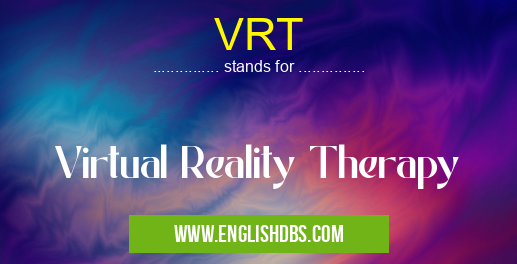What does VRT mean in THERAPY
VRT (Virtual Reality Therapy) is a type of immersive therapy that utilizes virtual reality (VR) technology to provide a safe and controlled environment for individuals to confront and overcome various psychological and physical challenges. It involves the use of VR headsets and sensory simulations to create realistic and interactive experiences that facilitate therapeutic interventions.

VRT meaning in Therapy in Medical
VRT mostly used in an acronym Therapy in Category Medical that means Virtual Reality Therapy
Shorthand: VRT,
Full Form: Virtual Reality Therapy
For more information of "Virtual Reality Therapy", see the section below.
What does VRT Stand for?
VRT stands for Virtual Reality Therapy.
How VRT Works
VRT immerses individuals in simulated environments that mimic real-world situations or scenarios. This controlled setting allows therapists to customize the experience to suit the specific needs and goals of the client. Through virtual reality, individuals can engage with virtual objects, interact with virtual characters, and experience sensory stimuli that are tailored to their therapeutic objectives.
Applications of VRT
VRT has a wide range of applications in various medical and therapeutic settings, including:
- Anxiety Disorders: VRT can help individuals with anxiety disorders, such as social anxiety or specific phobias, by gradually exposing them to fear-provoking situations in a safe and supported environment.
- Pain Management: VRT has been shown to reduce pain perception and improve coping mechanisms for individuals experiencing chronic pain.
- Rehabilitation: VRT can assist in rehabilitation processes for individuals with physical impairments, providing virtual environments for practicing motor skills and functional movements.
- Cognitive Training: VRT can be used to enhance cognitive function and improve memory in individuals with cognitive impairments.
Benefits of VRT
VRT offers several benefits over traditional therapy methods:
- Immersive Experience: VR technology creates highly immersive experiences that enhance engagement and motivation.
- Safety and Control: The controlled environment of virtual reality allows therapists to adjust the difficulty and intensity of therapeutic experiences to ensure safety and comfort.
- Flexibility and Accessibility: VRT can be delivered in various settings, including clinics, hospitals, and even home environments, increasing accessibility for individuals.
- Enhanced Motivation: The interactive and engaging nature of VRT can increase motivation and adherence to therapeutic interventions.
Essential Questions and Answers on Virtual Reality Therapy in "MEDICAL»THERAPY"
What is Virtual Reality Therapy (VRT)?
VRT utilizes computer-generated environments and simulations to create immersive experiences for therapeutic purposes. It allows individuals to interact with virtual worlds and engage in simulated scenarios designed to address specific psychological and physical issues.
What conditions can VRT help treat?
VRT has been effectively used in treating a wide range of conditions, including anxiety disorders, phobias, pain management, PTSD, and rehabilitation. It provides a safe and controlled environment for individuals to confront their fears, practice coping mechanisms, and improve their well-being.
How does VRT work?
VRT immerses individuals in simulated experiences that mimic real-world situations. Through these simulations, therapists can guide individuals through controlled exposures to their triggers, allowing them to develop coping strategies and overcome emotional and behavioral challenges.
Is VRT effective?
Yes. Numerous studies have demonstrated the effectiveness of VRT in reducing symptoms and improving outcomes for various conditions. It has been shown to be comparable or even superior to traditional therapies in many cases.
Are there any risks associated with VRT?
VRT is generally considered safe when used under the supervision of qualified therapists. However, as with any therapy, there are potential risks, such as discomfort or distress during simulations. Therapists carefully monitor individuals and adjust the experiences accordingly to minimize any adverse effects.
Who is a suitable candidate for VRT?
VRT is suitable for individuals who are experiencing psychological or physical challenges and are motivated to improve their well-being. It is essential to consult with a qualified therapist to determine if VRT is an appropriate option for your specific needs.
Final Words: VRT represents an innovative and effective approach to therapy that harnesses the power of virtual reality technology. By creating immersive and controlled environments, VRT empowers individuals to confront their challenges, improve their well-being, and achieve their therapeutic goals in a safe and supportive setting. As VR technology continues to advance, the applications and benefits of VRT are expected to expand, revolutionizing the delivery of therapeutic interventions and improving outcomes for individuals seeking mental and physical health support.
VRT also stands for: |
|
| All stands for VRT |
